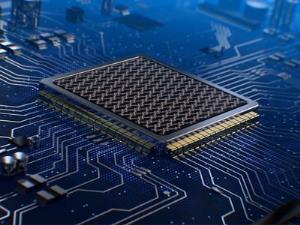



Date:13/04/20
 Emitting light from silicon has been the Holy Grail in the microelectronics industry for decades. Solving this puzzle would revolutionize computing, as chips will become faster than ever. Researchers from Eindhoven University of Technology have now developed an alloy with silicon that can emit light. The results have been published in the journal Nature. The team will now develop a silicon laser to be integrated into current chips.
Emitting light from silicon has been the Holy Grail in the microelectronics industry for decades. Solving this puzzle would revolutionize computing, as chips will become faster than ever. Researchers from Eindhoven University of Technology have now developed an alloy with silicon that can emit light. The results have been published in the journal Nature. The team will now develop a silicon laser to be integrated into current chips.
Current technology based on semiconductors is reaching its ceiling. The limiting factor is heat, resulting from the resistance that the electrons experience when traveling through the copper lines connecting the many transistors on a chip. To continue advancing data transfer requires a new technique that does not produce heat.
In contrast to electrons, photons do not experience resistance. As they have no mass or charge, they will scatter less within the material they travel through, and therefore no heat is produced. Energy consumption will therefore be reduced. Moreover, by replacing electrical communication within a chip by optical communication, the speed of on-chip and chip-to-chip communication can be increased by a factor of 1000. Data centers would benefit most, with faster data transfer and less energy usage for cooling systems. But these photonic chips will also bring new applications within reach. Think of laser-based radar for self-driving cars and chemical sensors for medical diagnosis or for measuring air and food quality.
Researchers present revolutionary light-emitting silicon
 Emitting light from silicon has been the Holy Grail in the microelectronics industry for decades. Solving this puzzle would revolutionize computing, as chips will become faster than ever. Researchers from Eindhoven University of Technology have now developed an alloy with silicon that can emit light. The results have been published in the journal Nature. The team will now develop a silicon laser to be integrated into current chips.
Emitting light from silicon has been the Holy Grail in the microelectronics industry for decades. Solving this puzzle would revolutionize computing, as chips will become faster than ever. Researchers from Eindhoven University of Technology have now developed an alloy with silicon that can emit light. The results have been published in the journal Nature. The team will now develop a silicon laser to be integrated into current chips.Current technology based on semiconductors is reaching its ceiling. The limiting factor is heat, resulting from the resistance that the electrons experience when traveling through the copper lines connecting the many transistors on a chip. To continue advancing data transfer requires a new technique that does not produce heat.
In contrast to electrons, photons do not experience resistance. As they have no mass or charge, they will scatter less within the material they travel through, and therefore no heat is produced. Energy consumption will therefore be reduced. Moreover, by replacing electrical communication within a chip by optical communication, the speed of on-chip and chip-to-chip communication can be increased by a factor of 1000. Data centers would benefit most, with faster data transfer and less energy usage for cooling systems. But these photonic chips will also bring new applications within reach. Think of laser-based radar for self-driving cars and chemical sensors for medical diagnosis or for measuring air and food quality.
Views: 389
©ictnews.az. All rights reserved.Similar news
- Azerbaijani project to monitor disease via mobile phones
- Innovative educational system to be improved under presidential decree
- NTRC prolongs license of two TV and radio organizations for 6 years
- Azerbaijan establishes e-registry for medicines
- Azerbaijani museum introduces e-guide
- Nar Mobile opens “Nar Dunyasi” sales and service center in Siyazan city
- International conference on custom electronic services held in Baku
- OIC secretary general to attend COMSTECH meeting in Baku
- Azerbaijan develops earthquake warning system
- New law to regulate transition to digital broadcasting in Azerbaijan
- Azerbaijani State Social Protection Fund introduces electronic digital signature
- Intellectual traffic management system in Baku to be commissioned in December
- Tax Ministry of Azerbaijan started receiving video-addresses
- World Bank recommends Azerbaijan to speed up e-service introduction in real estate
- Azerbaijan to shift to electronic registration of real estate





















